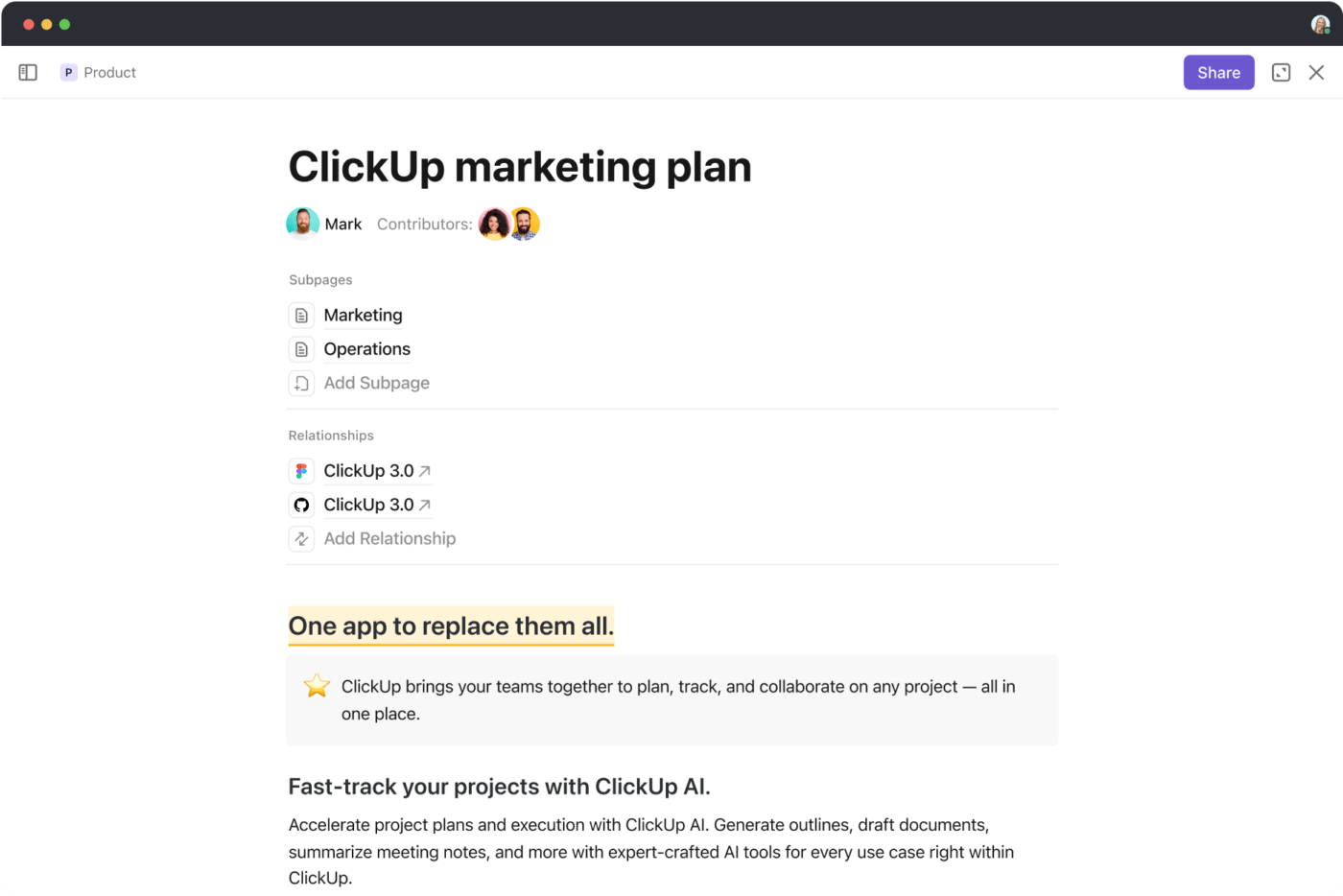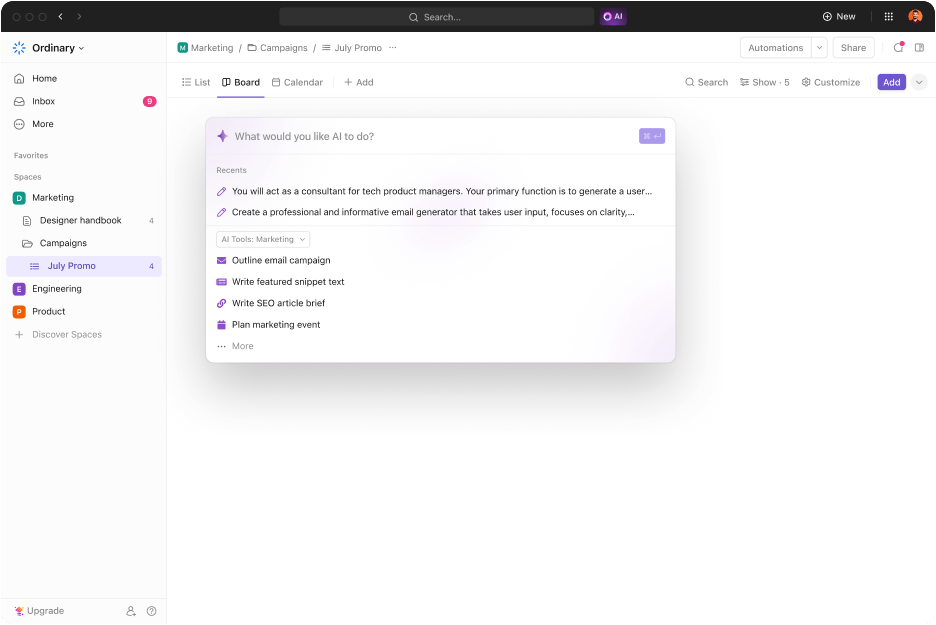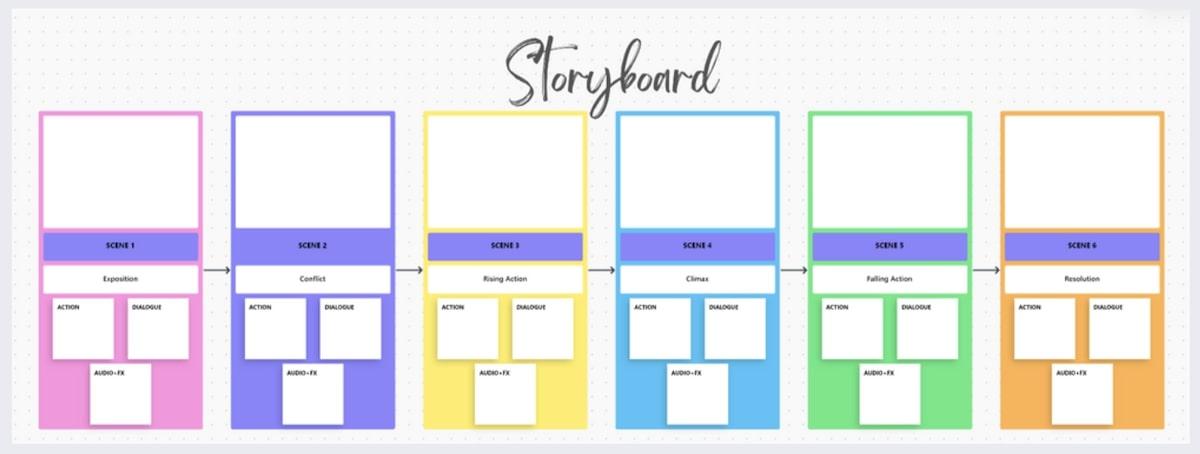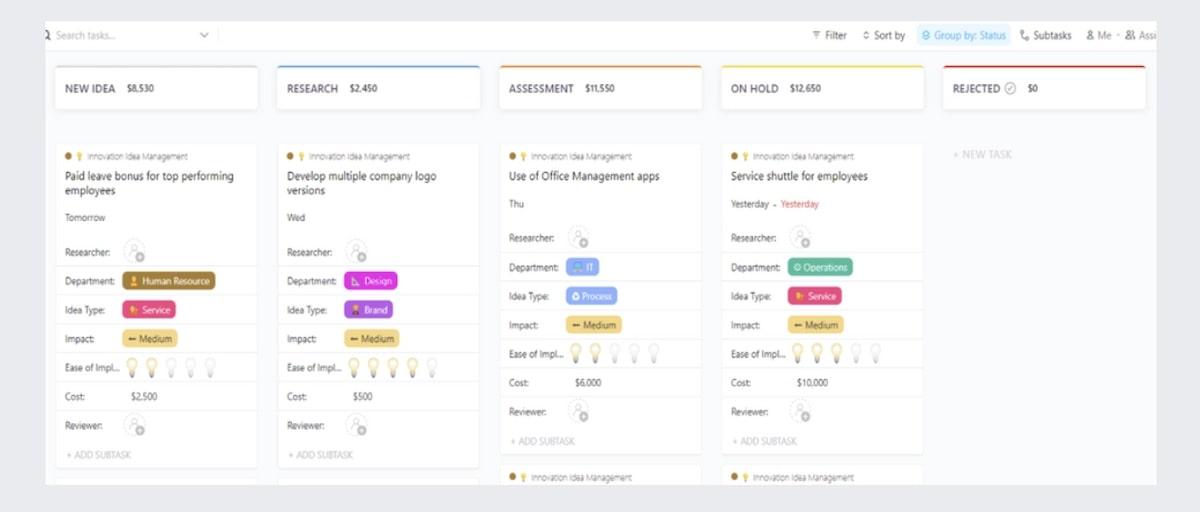قال نابليون هيل ذات مرة: "الأفكار هي نقاط البداية لكل الثروات"
قد تكون فكرة واحدة قوية كافية لإشعال ثورة. مثال على ذلك؟ بدأت Netflix كخدمة تأجير أقراص DVD. كان هدف المؤسسين ريد هاستينغز ومارك راندولف تبسيط عملية تأجير الأفلام، ولكن سرعان ما تحولوا إلى خدمة البث المباشر. وقد أدى هذا القرار إلى تغيير استهلاك الوسائط وأطلق شرارة ثقافة المشاهدة بنهم.
ولكن تحويل الأفكار الحالية إلى واقع ملموس ليس بالأمر السهل. فهو يتطلب مزيجًا من الإبداع والاستراتيجية والمثابرة.
هل هناك طريقة لعكس هذه العملية؟ تقنيات توليد الأفكار تساعدك في التغلب على الركود الإبداعي وتحويل أفكارك إلى خطط قابلة للتنفيذ. دعنا نستكشف هذه التقنيات ودورها في جلسات توليد الأفكار الناجحة.
فهم توليد الأفكار
ما هي عملية توليد الأفكار؟
عملية توليد الأفكار، أو توليد الأفكار، هي المرحلة الأولية من عملية إدارة الأفكار التي تتضمن إنشاء الأفكار وتطويرها وتنقيحها. إنها خطوة حاسمة في المساعدة على حل المشكلات والابتكار.
على سبيل المثال، تستخدم إحدى العلامات التجارية لملابس اللياقة البدنية التي تواجه منافسة شديدة تقنيات العصف الذهني لتطوير أفكار مختلفة، مثل معدات التمارين الرياضية القابلة للتخصيص، وصندوق اشتراك للمجموعات الموسمية، ومنصة مجتمعية لعشاق اللياقة البدنية. يساعد تنفيذ هذه المفاهيم على إبراز العلامة التجارية وبناء الولاء وزيادة المبيعات.
ما هي المراحل الثلاث لتوليد الأفكار؟
تتكون عملية توليد الأفكار من ثلاث مراحل رئيسية:
الإلهام
يقوم الأفراد وفرق العمل بجمع المعلومات والبحث عن أفكار جديدة باستخدام أبحاث السوق وتعليقات المستخدمين واتجاهات الصناعة ومراقبة المنافسين. والهدف من ذلك هو إنشاء مجموعة غنية من الأفكار التي يمكن أن تثير الإبداع.
الحضانة
يتراجع الفرد عن المشكلة، تاركًا العقل يرتاح. بينما يتجول العقل الواعي، ينخرط اللاوعي في ما أطلق عليه أينشتاين "اللعب التوليفي" - مزج الأفكار المتنوعة لاكتشاف حلول مبتكرة.
الإضاءة
تصبح الأفكار ملموسة، ويمكن للفريق أن يصقلها أكثر ويستعد لتنفيذها. ينتقل التركيز إلى تقييم جدواها وتأثيرها المحتمل.
## 12 تقنية لتوليد الأفكار الفعالة
والآن، دعونا نناقش 12 تقنية لتوليد الأفكار التي تنتج حلولاً فعالة.
1. العصف الذهني
العصف الذهني، أو التفكير الذهني، هو عملية إبداعية يقوم فيها الأفراد أو المجموعات بتوليد الأفكار دون إصدار أحكام. والغرض منه هو إنتاج أكبر عدد ممكن من الأفكار، والتي يمكن تقييمها أو دمجها أو تنقيحها لاحقًا لحل تحدٍ معين.
يحفز هذا النهج التفكير الإبداعي، ويقدر جميع المساهمات على قدم المساواة، ويعزز التعاون.
مثال: فريق تسويق العصف الذهني للأفكار لحملة تيك توك لتعزيز المشاركة بين مستخدمي الجيل Z. للقيام بذلك بفعالية:
- حدّد المشكلة - كيف يمكننا إنشاء حملة على تيك توك تلقى صدى لدى جيل Z وتزيد من المشاركة بنسبة 30% في الربع القادم؟
- شجع الأعضاء على مشاركة اقتراحاتهم مثل إنشاء مقاطع فيديو للتحديات، والشراكة مع المؤثرين من جيل Z، واستخدام مقاطع صوتية رائجة على تيك توك
- قم بتدوين جميع الاقتراحات على لوحة رقمية - من المفاهيم العملية إلى الأفكار الجامحة مثل تميمة العلامة التجارية الراقصة
- قم بتجميع الأفكار المتشابهة، مثل الشراكات مع المؤثرين والتحديات، وصقلها
- اطلب من الأعضاء التصويت على أفضل ثلاثة مفاهيم قوالب العصف الذهني توفر أطر عمل منظمة تلتقط جميع الأفكار وتنظمها بفعالية.
على سبيل المثال، فإن قالب العصف الذهني ClickUp يساعد في جمع أفكار جديدة من أعضاء الفريق وأصحاب المصلحة. بالإضافة إلى ذلك، تساعد حقولها الستة المخصصة - مثل "وصف المشكلة" و"الموارد" و"الحل الفائز" - في تصنيف الأفكار لمزيد من المناقشة.
قالب العصف الذهني ClickUp
يمكنك أيضًا الوصول إلى بيانات العصف الذهني من خلال ست طرق عرض: طريقة عرض القائمة، وطريقة عرض الجدول الزمني، وطريقة عرض القسم، وطريقة عرض حسب المراحل، وطريقة عرض الأولويات.
يمكنك أيضًا استخدام قالب أفكار العصف الذهني ClickUp الذي يشجع أعضاء الفريق على تحديد أفضل الأفكار باستخدام معايير محددة وقابلة للقياس وقابلة للتحقيق وذات صلة ومحددة زمنيًا، ويوفر مساحة للوصف التفصيلي للأفكار المعقدة.
2. الخرائط الذهنية
يتضمن رسم الخرائط الذهنية إنشاء شبكة مرئية من الأفكار المترابطة. تبدأ من خلال التقاط فكرة مركزية في منتصف الصفحة ثم تتفرع لربط الأفكار المرتبطة ببعضها البعض. يمكن أن يؤدي كل فرع إلى فروع أصغر مع مزيد من التفاصيل. حالات استخدام الخريطة الذهنية تتراوح من إدارة المشاريع وإنشاء المحتوى وتخطيط الأحداث إلى استراتيجيات التسويق وتطوير المنتجات.
مثال:
تخيل أنك تقوم بإعادة تصميم موقع إلكتروني. لإنشاء خريطة ذهنية:
1. اكتب "إعادة تصميم موقع إلكتروني" في منتصف المخطط التفصيلي
2. من هناك، ارسم فروعًا للفئات الرئيسية، مثل تجربة المستخدم واستراتيجية المحتوى والتصميم المرئي
3. بعد ذلك، أضف فروعاً فرعية توضح بالتفصيل إجراءات أو عناصر محددة، مثل
- تجربة المستخدم
- تحسينات التنقل
- استجابة الهاتف المحمول
- ميزات إمكانية الوصول الخرائط الذهنية ل ClickUp بتحويل أفكارك إلى خرائط ذهنية منظمة يسهل مشاركتها مع فريقك. يمكن للجميع تصور سير العمل والتعاون في التعديلات بسلاسة.

تصور كيف تنبثق الأفكار المتعددة المرتبطة من فكرة مركزية باستخدام الخرائط الذهنية ClickUp Mind Maps
لإنشاء خريطة ذهنية، يمكنك الاختيار بين:
- وضع المهمة: تصوّر خريطتك الذهنية الحاليةانقر فوق المهام ورسم خريطة لسير عمل المشروع. أعد ترتيب المهام في تسلسلات منطقية وأنشئ المهام (والمهام الفرعية) وعدّلها واحذفها مباشرةً من خريطتك الذهنية
- الوضع الفارغ: ابدأ من الصفر، وأنشئ عددًا غير محدود من العُقد، وقم بتوصيلها كيفما تشاء. عندما تكون جاهزًا، قم بتحويل هذه العقد إلى مهام في أي قائمة مهام في أي قائمة مهام في مساحة العمل الخاصة بك
اقرأ المزيد: أفضل 9 أدوات برمجية للوحة المزاج لتنظيم أفكار التصميم بشكل متماسك
3. سكامبر
SCAMPER تعني استبدال، أو دمج، أو تكييف، أو تعديل (أو تكبير)، أو استخدام آخر، أو إلغاء، أو عكس، أو إعادة ترتيب.
إنها واحدة من أكثر الكلمات الفعالة التقنيات الإبداعية تُستخدم لتبادل الأفكار وتحسين المنتجات أو العمليات الحالية. وهي تشجع على التفكير الابتكاري من خلال حث المستخدمين على استكشاف الجوانب المختلفة للمشكلة.
مثال: لنفترض أنك تقوم بتطوير جهاز تعقب لياقة بدنية جديد. إليك كيفية تطبيق هذه الطريقة:
- الاستبدال: استخدام تقنية تعمل بالطاقة الشمسية بدلاً من البطاريات التقليدية لإطالة عمر البطارية وتقليل النفايات الكيميائية
- الجمع بين: دمج متتبع اللياقة البدنية مع ساعة ذكية لتضمين الإشعارات والتطبيقات
- التكيف: دمج ميزات من الملابس الذكية، مثل المواد التي تمتص الرطوبة لتوفير الراحة أثناء التدريبات
- التعديل: تغيير الشكل إلى تصميم أنحف وأكثر راحة لملاءمة أفضل للمعصم
- ضعه في استخدام آخر: تسويق جهاز التتبع لمراقبة صحة الحيوانات الأليفة من خلال تكييفه مع أطواق الحيوانات الأليفة
- الإزالة: إزالة الشاشة للحصول على تصميم أبسط يركز فقط على تتبع البيانات من خلال الاهتزازات
- الإلغاء: إعادة ترتيب واجهة المستخدم للسماح للأوامر الصوتية للتشغيل بدون استخدام اليدين أثناء التدريبات
4. تحليل SWOT
تحليل SWOT (نقاط القوة والضعف والفرص والتهديدات) هو أداة استراتيجية لتقييم إيجابيات وسلبيات موقف أو مشروع أو فكرة معينة.
مثال: عند تطوير أداة جديدة لإدارة وسائل التواصل الاجتماعي، ضع في اعتبارك ما يلي:
- نقاط القوة: حدد أفضل وظائف أداتك الحالية التي تعزز تجربة المستخدم
- نقاط الضعف: تحديد أي قيود أو مجالات تفتقر إلى الكفاءة
- الفرص: فكر في الاتجاهات في إدارة وسائل التواصل الاجتماعي التي يمكن لأداتك الاستفادة منها
- التهديدات: قم بتحليل نقاط قوة الأداة المنافسة لضمان تميز عرضك
الفوائد واضحة: فهي تقدم رؤية متوازنة للعوامل الداخلية والخارجية، وتساعد في عمليات اتخاذ القرار، وتصلح لأي نطاق من المشاريع أو الأفكار.
لتبسيط الأمور، استخدم ClickUp نموذج تحليل SWOT الشخصي . إنه أكثر من مجرد تقييم ذاتي؛ إنه خارطة طريق لتحقيق أهدافك وتعظيم إمكاناتك.
ClickUp نموذج تحليل SWOT الشخصي
يمكنك تحديد مجالات التطوير والتعرف على نقاط قوتك في حياتك المهنية والشخصية. بالإضافة إلى ذلك، يمكنك فهم صفاتك الفريدة والعوامل الخارجية لمواءمة أهدافك مع قيمك الشخصية.
5. العصف الذهني العكسي
يُعرف أيضًا باسم العصف الذهني السلبي، ويشجع هذا الأسلوب المشاركين على التفكير في كيفية التسبب في مشكلة ما بدلاً من حلها.
وهذا يساعد الفرق على الكشف عن العقبات المحتملة التي ربما أغفلوها. ومن خلال التركيز على النتائج السلبية، يمكنهم تطوير حلول أكثر عملية وقابلة للتنفيذ.
مثال: فيما يلي كيف يمكن لشركة تعاني من ارتفاع معدل دوران الموظفين أن تستخدم هذه التقنية لتحسين الاحتفاظ بالموظفين:
- اذكر المشكلة: في هذه الحالة، المشكلة هي ارتفاع معدل دوران الموظفين
- اطرح أسئلة عكسية: بدلاً من البحث عن استراتيجيات الاحتفاظ بالموظفين، اسأل "ما هي الإجراءات التي من شأنها أن تجعل الموظفين يستقيلون بشكل أسرع؟
- استنباط الأفكار: قد يقترح المشاركون أشياء مثل "خلق بيئة عمل سامة"، أو "الحد من فرص النمو"، أو "تقليل التواصل والتغذية الراجعة"، أو "إثقال كاهل الموظفين بالعمل
- التحليل والعكس: هذه الأفكار تسلط الضوء على المجالات التي يجب تجنبها أو تحسينها
على سبيل المثال، يمكن للشركة إنشاء مسارات وظيفية وبرامج تدريبية واضحة أو بناء ثقافة التواصل المنتظم والبنّاء.
6. العصف الذهني على السبورة البيضاء
تستخدم هذه التقنية التعاونية المرئية لوحة بيضاء لرسم الأفكار وتطويرها في الوقت الفعلي.
وهي تشجع التواصل الحر والإبداع، مما يسمح للمشاركين برسم الأفكار بصريًا وإجراء الروابط والبناء على مساهمات بعضهم البعض.
مثال: عند إنشاء دورة تدريبية جديدة عبر الإنترنت حول التسويق الرقمي، إليك كيفية استخدامها:
- قم بتجميع فريق من المعلمين والمسوقين والمصممين التعليميين لتبادل الأفكار
- شجّع أعضاء الفريق على مشاركة الأفكار لمحتوى الدورة التدريبية، مثل أفضل ممارسات تحسين محركات البحث، واستراتيجيات وسائل التواصل الاجتماعي، وما إلى ذلك.
- توثيق جميع الأفكار على السبورة البيضاء وتصنيف المفاهيم ذات الصلة إلى موضوعات أساسية (مثل أفضل ممارسات تحسين محركات البحث، واستراتيجيات وسائل التواصل الاجتماعي) ومحتوى تكميلي (مثل نصائح إنشاء المحتوى، والتحليلات)
- إنشاء خطوات قابلة للتنفيذ، مثل وضع الخطوط العريضة لوحدات الدورة التدريبية وتحديد المتحدثين الضيوف وتصميم المواد الترويجية للإطلاق
إعداد قالب سبورة الأفكار ClickUp يبسط هذه العملية، مما يسمح للمستخدمين بتدوين الأفكار وتصنيفها بسرعة حتى لا تمر أي فكرة عظيمة دون أن يلاحظها أحد.
قالب السبورة البيضاء ClickUp Ideation
يمكن للفرق تقييم التأثير والجهد المحتمل لكل فكرة، والتركيز على ما هو مهم حقًا. بالإضافة إلى ذلك، يمكنك تتبع التقدم المحرز في الأهداف قصيرة الأجل والمشاريع طويلة الأجل، مما يحافظ على توافق الجميع وتحفيزهم.
7. الكتابة الدماغية
الكتابة الدماغية هي تقنية يقوم فيها المشاركون بكتابة أفكارهم بدلاً من التحدث بها بصوت عالٍ ثم تمريرها للآخرين للبناء عليها. وهذا يسمح بمزيد من المساهمات المدروسة دون تأثير التفكير الجماعي أو الشخصيات المهيمنة.
مثال: فريق تطوير برمجيات يريد إنشاء ميزات لأداة جديدة لإدارة المشاريع.
- يكتب كل عضو أفكاره بشكل مستقل، مثل أتمتة المهام وتتبع الوقت ووظيفة الدردشة المتكاملة
- ثم يمررون ملاحظاتهم إلى الشخص التالي، الذي يبني على الأفكار. على سبيل المثال، إضافة مكالمات فيديو إلى وظيفة الدردشة واقتراح تذكيرات آلية للمهام
- وتستمر هذه العملية التكرارية لعدة جولات، مما ينتج عنه مجموعة من الميزات المحسنة والشاملة
اقرأ المزيد: أفضل 10 أدوات برمجية لمخططات التقارب لتنظيم الأفكار
8. 5 أسباب
يساعد أسلوب الأسباب الخمسة في تحديد السبب الجذري للمشكلة من خلال تكرار السؤال "لماذا؟" وعادةً ما يكون طرح السؤال "لماذا؟" خمس مرات كافياً للوصول إلى جوهر المشكلة، على الرغم من أن الأمر قد يستغرق أكثر أو أقل من التكرار.
والهدف من ذلك هو التعمق في المشكلة من خلال فحص علاقات السبب والنتيجة الكامنة وراءها. وهذا يسمح للفرق بتبادل الأفكار الإبداعية التي تعالج المشكلة الحقيقية، وليس فقط الحلول السريعة.
مثال: لتحديد السبب الجذري لانخفاض المبيعات في أحد متاجر البيع بالتجزئة، يستخدم الفريق تقنية الأسباب الخمسة:
- السبب الأول: لماذا انخفضت المبيعات؟ لأن الزبائن لا يشترون المنتجات
- السبب الثاني: لماذا لا يشتري الزبائن السلع؟ لأنهم يشتكون من ارتفاع الأسعار
- السبب الثالث: لماذا يعتقدون أن الأسعار مرتفعة؟ لأن أسعارنا أعلى من أسعار المنافسين
- الرابع لماذا: لماذا أسعارنا أعلى من أسعار المنافسين؟ لأننا رفعنا الأسعار لتغطية تكاليف التوريد المرتفعة
- خامسًا لماذا: لماذا زادت تكاليف التوريد؟ لأن موردنا الرئيسي رفع الأسعار بسبب زيادة تكاليف الشحن
السبب الجذري: أدى اعتماد المتجر على مورد واحد إلى زيادة التكاليف وارتفاع أسعار التجزئة مما أدى إلى عزوف العملاء عن الشراء.
لتجنب تخطي الخطوات الحرجة، استخدم قالب ClickUp 5 Whys . من خلال أقسام محددة مسبقًا لتوثيق كل "لماذا"، يساعد القالب الفرق في الحفاظ على التنظيم والتركيز أثناء التحقيق في المشكلة.
نموذج ClickUp 5 Whys
يسهل القالب أيضًا التعاون، مما يسمح للعديد من أعضاء الفريق بالمساهمة برؤاهم وملاحظاتهم في الوقت الفعلي.
9. القصص المصورة
القصة المصورة هي عملية تصور مرئية تتضمن رسم خريطة لقصة أو عملية باستخدام سلسلة من الصور أو الرسوم التوضيحية. وهي رائعة لتخطيط المشاريع مثل الحملات التسويقية وتصميم تجربة المستخدم.
مثال: تخيل تصميم تطبيق لتوصيل الطعام يقدم رحلة مستخدم سلسة للعملاء الذين يستخدمونه لأول مرة.
- قسّم رحلة المستخدم إلى مشاهد - لكل منها لوحة خاصة به
- لكل لوحة، ارسم ما يحدث:
- اللوحة 1 (فتح التطبيق): عرض شاشة رئيسية بسيطة مع رسالة ترحيبية وزر "البدء
- اللوحة 2 (تصفح المطاعم): توضيح قائمة المطاعم القريبة مع الصور والتقييمات، مع التركيز على خيار "تصفية" لأنواع المأكولات
- اللوحة 3 (إضافة عناصر إلى عربة التسوق): توضيح قائمة المطاعم حيث يمكن للمستخدمين اختيار العناصر ورؤيتها تضاف إلى سلة التسوق الخاصة بهم
- اللوحة 4 (تسجيل الخروج): إنشاء شاشة تسجيل الخروج للمستخدمين لإدخال عنوان التوصيل، واختيار خيارات الدفع، وعرض ملخص الطلبات
- اللوحة 5 (استلام تأكيد الطلب): اعرض شاشة تأكيد مع الوقت المقدر للتسليم وخيار التتبع
- رتب اللوحات بالترتيب الدقيق الذي يختبرها به المستخدم
- تأكد من أن لوحة القصة المصغرة تتدفق بشكل منطقي وسهل الاستخدام، وتسلط الضوء على الميزات الرئيسية مثل الفلاتر وتتبع الطلبات
يمكن أن تصبح القصة المصورة فوضوية بدون تنسيق محدد مسبقًا. قد يفقد المصممون مسار التسلسل، مما يؤدي إلى لوحة عمل غير منظمة. وهنا يأتي دور قوالب لوحة القصة المصورة يمكن أن تساعد.
يمكن لـ قالب ClickUp Storyboard يتيح للمستخدمين وضع المشاهد والشخصيات والنصوص وغيرها من التفاصيل المهمة بتنسيق منظم - مما يسهل تصور المشروع بأكمله قبل التنفيذ.
قالب ClickUp Storyboard
يمكنك أيضًا تتبع تقدم كل مشهد باستخدام حالات وحقول مخصصة. بالإضافة إلى ذلك، قم بتصنيف وإدارة عناصر لوحة العمل بفعالية.
10. اقتحام الأدوار
العصف بالأدوار هو نوع مختلف من العصف الذهني حيث يتقمص المشاركون شخصيات أو أدوارًا مختلفة لتوليد الأفكار من وجهات نظر مختلفة. وهذا يشجع على التفكير الإبداعي من خلال جعل الأفراد يفكرون في كيفية رؤية أصحاب المصلحة المختلفين للمشكلة أو الحل.
مثال: يقوم فريق تسويق بعصف ذهني للأفكار لإطلاق منتج جديد. يتولى كل عضو في الفريق دورًا مختلفًا، مثل:
- العميل المتحمس لأول مرة: يقترح دروساً تعليمية جذابة وتجارب فتح العلبة
- المشتري المتشكك: يثير المخاوف بشأن موثوقية المنتج ومتانته
- المؤثر على وسائل التواصل الاجتماعي: يركز على الجاذبية البصرية وقابلية المشاركة
- الناشط الواعي بيئياً: يقترح تغليفاً صديقاً للبيئة ومصادر مستدامة
11. الثمانيات المجنونة
Crazy Eights هو تمرين سريع للتفكير يدفع المشاركين إلى توليد ثماني أفكار أو مفاهيم مختلفة في غضون ثماني دقائق.
مثال: أثناء التخطيط لحملة شتوية لأحد المقاهي، يجتمع فريق التسويق حول لوحة أفكار مقسمة إلى ثمانية أقسام وتعيين مؤقت لثماني دقائق.
- الدقيقة الأولى: حملة "استمتع بالدفء معنا" التي تعرض أمسيات مريحة مع موسيقى حية ومشروبات خاصة
- الدقيقة الثانية: حملة "نكهة الأسبوع الشتوية" التي تقدم مشروبات موسمية فريدة من نوعها كل أسبوع
- الدقيقة الثالثة: عرض "اشترِ واحد واحصل على واحد مجاناً" لتشجيع الزيارات الجماعية
- الدقيقة الرابعة: تحدي وسائل التواصل الاجتماعي حيث ينشر العملاء صوراً لمشروباتهم الشتوية للحصول على فرصة للفوز بقهوة مجانية
- الدقيقة الخامسة: عرض "القهوة والكعك" الذي يجمع بين المشروبات الساخنة والكعك المنزلي المخفض
- الدقيقة السادسة: ورش عمل لتحضير القهوة للعملاء لتعلم كيفية تحضير مشروباتهم المفضلة
- الدقيقة السابعة: بطاقة الولاء "Frequent Sipper" التي تكافئ العملاء بمشروب مجاني بعد عدد معين من عمليات الشراء
- الدقيقة الثامنة: عرض "الركن المريح" مع بطانيات ومدافئ لتجربة مشروب مريحة
بعد مرور ثماني دقائق، يقوم الفريق بمراجعة فكرة أو فكرتين ووضع اللمسات الأخيرة عليها لوضع استراتيجية تسويقية جذابة.
12. ربط الكلمات العشوائية
تستخدم طريقة الربط العشوائي للكلمات كلمات غير مترابطة في جلسات العصف الذهني. يتيح ذلك للمشاركين التحرر من العمليات الشائعة لحل المشكلات واكتشاف حلول غير تقليدية.
مثال: لنفترض أن فريقًا ما يخطط لميزات تطبيق لتوليد الفواتير، والكلمة العشوائية هي "جسر":
- عضو آخر يربط "عبور" بـ "تذكيرات الدفع"، مما يلهم إشعارات تلقائية للعملاء عند استحقاق الفواتير
- يقترح أحد الأعضاء كلمة "اتصال"، مما يؤدي إلى ميزة "جسر العميل" التي تربط الفواتير بعملاء ومشاريع محددة
لا تقلق بشأن اختيار طريقة واحدة فقط - جرب مزيجًا من الاستراتيجيات المختلفة لاكتشاف ما يناسب فريقك!
توليد الأفكار وتوثيقها وتنفيذها بسلاسة مع ClickUp انقر فوق هي أداة فعالة لإدارة المشاريع تقدم مجموعة شاملة من الميزات لتلبية مختلف احتياجات إدارة المشاريع. تصميمها البديهي يجعل من السهل التقاط الأفكار وتنظيمها وتنقيحها، مما يضمن رؤية شاملة لجميع إمكانيات الحلول المبتكرة.
إليك كيف تساعدك هذه الأداة مستندات ClickUp يوفر مساحة مركزية للفرق لالتقاط الأفكار في الوقت الفعلي - سواء كنت تقوم بالعصف الذهني خلال اجتماع أو تلتقط الأفكار العفوية.

احصل على عرض سريع لجميع صفحاتك الفرعية المتصلة وعلاقاتك على مستندات ClickUp Docs لتظل منظمًا وتحافظ على اتصال العمل
يمكنك أيضًا مشاركة هذه المعلومات مع أعضاء الفريق ودعوتهم للمساهمة بأفكارهم واقتراحاتهم مباشرةً داخل المستند. بالإضافة إلى ذلك، قم بتضمين الصور أو مقاطع الفيديو أو الروابط أو المحتوى التفاعلي مباشرةً في مستندات ClickUp Docs لإضافة مراجع وأمثلة.
💡 نصيحة احترافية: قم بإعداد مستند ClickUp Doc كـ "أرشيف أفكار" حيث يمكنك تخزين الأفكار السابقة التي لم تنجح في البداية. قم بإعادة زيارة هذا الأرشيف كل ثلاثة أشهر - فقد تجد أن الفكرة التي لم تكن جاهزة في ذلك الوقت أصبحت الآن مناسبة تمامًا لمشروع حالي. ClickUp Brain يساعد المستخدمين في العثور على المعلومات الأساسية حول المهام والمستندات وأعضاء الفريق وتلخيصها، مما يوفر إجابات سريعة من جميع أنحاء مساحة العمل. أثناء توليد الأفكار، يمكن للفرق الوصول بسهولة إلى المعارف والرؤى الموجودة، مما يسهل البناء على الأفكار السابقة.

تسريع عملية وضع الأفكار من خلال الوصول إلى البيانات ذات الصلة عبر ClickUp Brain
يمكن ل ClickUp Brain أيضًا سحب البيانات من تقارير الصناعة المضمنة أو المستندات أو تطبيقات الطرف الثالث المتصلة. وهذا يساعد الفريق على تحديد الموضوعات الشائعة وتوليد أفكار جديدة للمحتوى.
يمكن ل قالب إدارة أفكار الابتكار ClickUp يساعدك على تنظيم وتتبع أفكارك من الفكرة إلى التنفيذ.
قالب إدارة أفكار الابتكار ClickUp
باستخدام هذا القالب، يمكنك
- تجميع الأفكار الجديدة بسهولة وتصنيفها باستخدام حقول مخصصة مثل التكلفة الفعلية والباحث والمراجع والتأثير ونوع الفكرة
- استخدام حالات مخصصة مثل معتمد، وتقييم، وفكرة جديدة، ومعلقة، ومرفوضة لمعرفة موقف كل فكرة
- إنشاء مهام من الأفكار الواعدة وتعيينها لأعضاء الفريق وتتبع الجداول الزمنية للتنفيذ السلس
اللوحات البيضاء لـ ClickUp توفر لوحة فارغة حيث يمكن للمستخدمين الرسم وإضافة الأشكال وتحميل الصور أو الروابط لتعزيز جلسات العصف الذهني.
يمكنك إنشاء خرائط مفاهيم مختلفة أو المخططات الانسيابية لمساعدة فريقك على تصور الروابط بين الأفكار وتطويرها بشكل أكثر فعالية.

قم بتحويل أفكارك إلى مهام داخل ميزة ClickUp Whiteboard
علاوةً على ذلك، يمكنك دعوة الأعضاء للمساهمة في السبورة في الوقت الفعلي، مما يجعلها أداة مثالية للفرق البعيدة لتبادل الأفكار معًا.
💡 نصيحة احترافية: اربط مفاهيم السبورة البيضاء مباشرةً بالمهام داخل ClickUp. بهذه الطريقة، يمكنك تحويل أفضل أفكارك بسرعة إلى خطط قابلة للتنفيذ.
كيف تعزز الإبداع والابتكار لتوليد الأفكار؟
لا تنبثق الأفكار العظيمة من العدم، بل يتم صياغتها. دعنا نناقش بعض الطرق لتوليد حلول جديدة ومبتكرة.
- تحديد المشكلة: يساعد بيان المشكلة المصاغ بشكل جيد المشاركين على فهم التحدي ويمهد الطريق لإجراء مناقشات مركزة. ومن خلال تضييق النطاق، يشجع ذلك على طرح أفكار مستهدفة وقابلة للتنفيذ، مما يؤدي إلى حلول أكثر فعالية
- تشجيع وجهات النظر المتنوعة: الجمع بين الأفراد من مختلف الخلفيات والخبرات والتخصصات يخلق مجموعة أكثر ثراءً من الأفكار. هذا التنوع يعزز وجهات النظر الفريدة والمقاربات المبتكرة التي لن تظهر في مجموعة متجانسة
- تخصيص وقت للإبداع: الإبداع، مثل أي مهارة، يزدهر بالممارسة. ومن خلال تخصيص وقت منتظم لتوليد الأفكار - سواء من خلال جلسات العصف الذهني أو ورش العمل أو اللقاءات غير الرسمية - فإنك تخلق ثقافةيصبح الابتكار طبيعة ثانية
- خلق مساحة آمنة للأفكار: تعزيز مساحة آمنة حيث يمكن لأعضاء الفريق مشاركة الأفكار دون خوف من النقد. من خلال تشجيع الانفتاح وتقدير جميع المساهمات - مهما كانت غير تقليدية - فإنك تعزز المشاركة وتطلق أفكارًا جديدة
اقرأ المزيد: أفضل 18 برنامجاً لإدارة الأفكار لتسهيل الابتكار
اجعل أفكارك تنبض بالحياة بفعالية
في عالم حيث التغيير هو الثابت الوحيد، فإن توليد الأفكار ليس مجرد ميزة، بل هو أمر ضروري. مع توفر تقنيات متعددة لتوليد الأفكار، يمكنك بناء نظام قوي لتتبع أفكارك وإدارتها.
بدءًا من القوالب البديهية التي توجه عملية العصف الذهني إلى الميزات القوية مثل اللوحات البيضاء والخرائط الذهنية للتنظيم المرئي، فإن ClickUp لديه كل ما تحتاجه لتحويل أفكارك إلى أفعال.
يوفر لك ClickUp Docs مساحة لتوثيق جلسات العصف الذهني ومشاركة الأبحاث والتعاون أثناء التنقل. يوفر ClickUp Brain رؤى واقتراحات، مما يضمن حصولك دائمًا على أحدث المعلومات للعمل بها.
هل أنت مستعد للارتقاء بجودة أفكارك؟ اشترك في ClickUp اليوم







